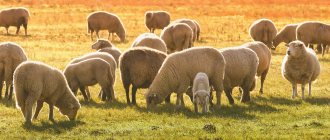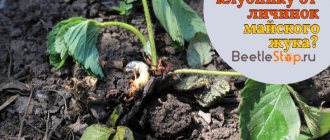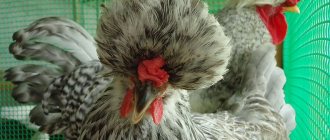Silage (Spanish silo) - succulent feed (silage feed) for farm animals; The word “silo” also refers to underground silo storage facilities.
In winter, it is an indispensable part of the diet for cows, horses and other farm animals, because silage contains many useful substances necessary in the cold season.
Photo:
Silage is a succulent feed that is prepared by canning greens.
Important! The main thing in ensiling is to create conditions so that lactic acid accumulation begins! The plant mass collected from the field and meadows is compacted into holes or trenches.
Over a certain period of time, the fermentation process begins, organic lactic acids (up to 2%) accumulate in the grass, which preserve the feed, protecting it from decomposition. Air access is of great importance.
If there is too much of it, the plants will begin to warm up, lose nutrients and mold will appear. So the amount of air access is reduced to a minimum!
The humidity of ensiled greens is maintained within 65-75%. If it is higher, lactic acid will accumulate slowly, and if the humidity is lower, the feed will not be able to compact tightly and there will be a lot of air inside.
To achieve the required moisture content, the feed is watered with plain water if necessary or straw and chaff are added.
Application
Silage is used in agriculture. It has high nutritional properties; its caloric content, vitamin content (contains carotene, vitamin C, organic acids) and dietary properties are comparable to fresh grass and is a valuable food product.
Silage improves digestion and promotes the absorption of other roughage. It is suitable for all kinds of herbivores and birds.
Such feed, stored in special silo storage facilities - special trenches, pits, silos, can be stored for several years.
To mechanize the storage of large volumes, silo towers are combined into silo buildings, which are part of the elevator.
6.Minimum silage removal speed
The size of the silo trench should be planned so that the weekly minimum excavation rate is 1-1.5 meters in winter and 2-2.5 meters in summer. If the harvesting speed is slower, the silage will begin to heat up, with accompanying energy losses and reduced feed intake by the animals. In this case, the livestock, the composition of the rations and the area of excavation from the silage trench must correspond to each other.
What are they made from?
Corn silage
Silage may vary depending on the crops it is made from:
- Corn is the most popular type of feed. Corn produces a high-quality product with a long shelf life. Corn silage can be made only from corn tops or together with cobs. It is always harvested during the period of milky-waxy or waxy ripeness.
- Meadow grass , healthy wild herbs, and waste are another good option for making silage. The final product is nutritious and of high quality.
- Rye, barley, and oats are usually sown mixed with legumes for subsequent ensiling. They go for ensiling during the period of milky-wax ripeness. They are stacked very tightly in silos. Corn silage is the most popular type of feed
- Alfalfa, legumes, nettles and clover are always ensiled together with grains (oats, rye, barley). By themselves, they are very useful and medicinal, but have low energy value. Legumes are harvested when young beans appear, and flowers are harvested during flowering.
- Sedge, reed and reed for ensiling are advantageous because they can be mowed 2-3 times per season.
The final product is quite good, considering its profitability. They are always collected before the panicle appears! Silage can also be made from sunflower, sudanese, sorghum, and chumiza.
Important! Animals love silage no less than hay or fresh grass. This is a very useful supplement that has a positive effect on the digestion of animals.
5. Duration of fermentation of corn silage
Corn silage should be fermented for a minimum of 3 weeks without any intervention, and the longer this period, the better the aerobic stability of the forage at harvest. Optimal conditions at the beginning of fermentation are visible from the characteristic gas bubble that forms above the trench. It indicates that the fermentation process began quickly, and preservative carbon monoxide is actively being formed. The bubble must not be punched or released by lifting the film. This will disrupt the fermentation process and provoke rotting processes.
Advantages and disadvantages
Ensilage
You can prepare animal feed for the winter using different methods. But it is silage that currently has the most advantages.
During ensiling, the loss of nutritional components is only 10%, and during drying, plants lose 25-40% of useful components.
Not only fresh grass is used for ensiling, but also crops such as wheat, corn, grass and waste (tops) from vegetable crops. Silage can be made from the fastest growing green crops.
Interesting! For silage, you can use both specially grown crops and those that grow naturally in meadows and fields.
Ensiling allows you to obtain relatively cheap succulent feed for the winter or during the dry period of summer. Collection of green mass for silage can be carried out in any weather.
Among the disadvantages, it is worth noting that making silage is not very easy, and buying it is not cheap. In addition, you need to be able to store this product correctly, otherwise it will quickly deteriorate. Source:
What is Silo
Silage is a succulent feed that is prepared by canning greens with limited access to oxygen; the harvesting process is called ensiling. In winter, it is an indispensable part of the diet for cows, horses and other farm animals, because silage contains many useful substances necessary in the cold season. To understand what silage is, it is worth understanding how it is obtained.
Silage is a succulent feed that is prepared by canning greens.
Important!
The main thing in ensiling is to create conditions so that lactic acid accumulation begins!
The plant mass collected from the field and meadows is compacted into holes or trenches. Over a certain period of time, the fermentation process begins, organic lactic acids (up to 2%) accumulate in the grass, which preserve the feed, protecting it from decomposition. Air access is of great importance. If there is too much of it, the plants will begin to warm up, lose nutrients and mold will appear. So the amount of air access is reduced to a minimum!
The humidity of ensiled greens is maintained within 65-75%. If it is higher, lactic acid will accumulate slowly, and if the humidity is lower, the feed will not be able to compact tightly and there will be a lot of air inside. To achieve the required moisture content, the feed is watered with plain water if necessary or straw and chaff are added.
Harvesting technique
The technology for making silage is called ensiling. To make silos, special pits, trenches, and towers are used. Holes and trenches are always dug in clay soil and lined with cement to prevent moisture from passing through the ground.
The preparation takes place in several stages:
- The green mass is collected from the field and brought to the harvesting site.
- Cereals, meadows, and legumes are crushed to 3 cm, and corn and sunflower to 5 cm.
- The resulting crushed mass is compacted into silo pits, trenches or towers. This entire process should take a minimum of time.
Optimal cover of the silage pile
- A layer of moistened clay 15-20 cm thick is poured on top of the green mass.
- If silage is prepared in the cool season, for example, in the fall, so that it does not start to freeze in the pit, straw and earth are also laid on top of the clay.
- Over the pits or trenches with the harvested silage, awnings, tents, and roofs are installed so that snow and rain cannot get inside.
- From corn, young grass, sunflower, grain grasses, silage is ready in 2-3 weeks. Legume silage takes longer to prepare and can only be used after 2-3 months. Only after this can you start testing it and selling it or using it to feed animals.
Important! Only fresh, high-quality silage can be used. Moldy product should not be given to animals, because it can cause severe stomach illnesses, especially for horses!
Silage preparation and storage technology
Easy-to-silage plants include: corn, sorghum, sudanese, sunflower, oats, vetch-oat mixture, peas (before flowering), rapeseed; difficult to silage - amaranth, sweet clover, alfalfa, lupine, quinoa, etc. For the preparation of silage, the main crop is corn in its pure form, mixed with sunflower and legumes. Additional crops can be sunflower-pea-oat mixtures and sweet sorghum.
To obtain nutritious, well-digestible silage from corn, it should be harvested in the stage of milky-waxy and waxy ripeness of the cobs, sunflower in the initial stage of flowering, and legume-cereal mixtures in the stage of bean formation.
Harvesting corn for silage in the phase of milky-waxy and waxy grain ripeness increases the yield of finished silage by 10-12%, digestible protein - by 7...11%, feed units - by 6...13%, sugar - by 1.6...2, 0% than when harvesting in the milky ripeness phase of grain. The optimal period for harvesting corn is 10…14 days. The lack of vehicles and forage harvesting equipment does not allow corn to be harvested within the specified time frame. Therefore, it is necessary to include corn hybrids of different early ripening in the silage conveyor - early ripening - 20...25%, mid-early - 50...60% and mid-ripening - 20...25%. To increase the protein content of corn feed, it is sown in a mixture with mallow, annual sweet clover and soybeans.
For silage, the most convenient are ground or semi-ground lined trenches with external walls being lined with soil. The optimal height of the walls is 3.5 m, width 10...12 m, and length depending on the total volume of the silo being harvested. So, a trench with a capacity of 1000 tons will have a length of approximately 60 m. At one of the ends of the trench there should be a hard-covered area 2 m wider than the width of the trench and at least 5 m long, onto which the green mass should be unloaded. Vehicles must not drive onto the silage material.
When storing silage in lined trenches, the loss of dry matter is 10...15%, in unlined trenches it increases to 30...35%. With the mound method, losses are also 30...35%.
The technological process of making silage from freshly cut plants includes the following operations: mowing with chopping and loading, transportation and unloading, leveling, compacting and sealing the silage mass in trenches. To mow corn in the waxy ripeness phase, combine harvesters KSK-100, KPKU-75, E-281, Jaguar, Don 680, etc. should be used.
The degree of grinding depends on the moisture content of the raw material. At a humidity of 70% or less, plants (except for corn in the phase of waxy grain ripeness) are crushed into particles up to 30 mm long, at a humidity of 71...75% up to 50 mm. Corn in the waxy ripeness phase should be crushed into particles up to 10...15 mm long.
The green mass is laid throughout the storage facility or at one end in inclined layers. The thickness of the daily laid layer when laying throughout the entire storage facility must be at least 0.8 m, the loading duration should be no more than three days for a trench wall height of 2.5 m and no more than five days for a height of 3.5 m or more. The green mass is moved from the site and placed in storage with a bulldozer, compacted with general purpose crawler tractors such as T-100, T-153, T-130, T-80, etc.
The optimal humidity of the mowed mass is 60...70%, the loss of nutrients when stored in trenches under films does not exceed 10...12%. In this case, no juice is released, which is important when meeting environmental protection requirements. From a mass with a moisture content of 75%, about 5% of the juice flows out of the amount placed in the trench, with a moisture content of 85% - 25% or more. The loss of nutrients from their decomposition to carbon dioxide and water increases approximately 2 times as a result of the intensive development of bacteria.
When ensiling green mass with high humidity, chopped straw should be added. The amount of straw required to reduce the moisture content of the silage material to the desired level is calculated using the formula:
X = (M - a)/(B - M) x 100,
where M is the desired dry matter content in the mixture, %; a - dry matter content in green mass, % B - dry matter content in straw, % X - amount of straw (t) must be added to 100 tons of green mass.
Perennial and annual herbs need to be wilted until the humidity drops to at least 70%.
First, chopped straw is placed at the bottom of the silo in a layer of 50...60 cm, then green mass (it is compacted), then chopped straw again, moving and distributing it with a bulldozer over the entire surface of the mass. Straw is not added to the top layer of silage mass 30...40 cm thick to improve compaction and reduce air inflow.
Green mass of excess moisture (more than 75%) when placed in trenches is compacted only during the process of laying and leveling with DT-75 type tractors. The mass with a moisture content of less than 75% is further compacted for 3…4 hours. If the temperature of the silage mass exceeds 37°C, the compaction time is increased.
A prerequisite for silage is the rapid filling of the trench. The daily layer of compacted mass should be at least 80 cm. The height of the silage mass in the middle part should not exceed 5 m. Filling silos takes no more than 5...7 days, and when canning feed with a high dry matter content - 3...4 days. After filling the storage or part of it (when laying the mass from the end), the silage mass, compacted and leveled with a slight increase towards the center of the trench, is covered with a polymer film, protecting it from access of air and precipitation. The film should be glued into panels by heat welding or using adhesive tape. The film is pressed over the entire surface with a small layer of earth (5...8 cm), peat (15...20 cm), sawdust (20...25 cm). You can cover the silo with loose straw (layer thickness 50...60 cm) or pressed straw (in one bale) to prevent freezing.
In the absence of a polymer film, to obtain high-quality silage, additional compaction of the mass should be carried out on the 10th and then on the 20th day after filling the trench. In the surface layer of the feed, the mass begins to burn and decompose. By compacting the layer that is beginning to deteriorate and thereby removing air from it, it is possible to stop the aerobic process without bringing it to the stage of rotting. The burnt mass, compacting, turns into a kind of protective film 6...8 cm thick, which later (during storage) prevents the penetration of air and moisture into the thickness of the silo. In this case, the trench is also covered with straw on top to prevent the silage from freezing in winter.
In the absence of film, other methods of covering trenches are used, but this usually leads to increased feed losses. Covering with soil only causes contamination of the feed and freezing of the ground, which can be difficult to remove when using feed. You can prevent the ground from freezing by laying straw in a layer of up to 1 m. Sometimes winter rye is sown on the soil, spread in a layer of 15...20 cm. Plants help bind the soil together with their roots and ensure that it is subsequently removed in a continuous layer, which reduces contamination of the feed. Covering trenches only with straw and other plant materials is also used. At the same time, one has to take into account the concentration of mice and other pests in them. Covering with unchopped straw (which does not prevent the penetration of water and air into the mass, which has poor thermal conductivity) usually does not reduce losses compared to uncovered feed. It is more reliable to cover the storage areas with chopped, moistened, tractor-compacted straw. It is moistened with water for 4…5 days. The straw mass decomposed under such conditions provides a protective layer for the feed. Sometimes cereals are sown on it, which contributes to its additional compaction. A method has been developed for covering silos with bales of straw or straw, which are pre-moistened with urea-formaldehyde resin with a hardener - acid (orthophosphoric, sulfuric or hydrochloric). As a result, rotting of the straw is prevented, the bale is monolithic, sticks together and does not crumble. Such bales can be used repeatedly for 3...8 years.
Another method of covering a silo is of some interest. The surface of the green mass is treated with a preservative, then covered with straw with a layer of 0.1...0.5 m. The straw is pre-moistened with a saturated solution of table salt to a moisture content of 30...35% and treated with crystalline table salt (10...18 kg/t). Next, the straw is covered with film. The film is laid out overlapping from corner to corner of the panel with a single tape, like a bandage. In this case, the straw is easily eaten, and freezing into clumps due to the table salt content is completely prevented. When the feed is removed, the film is gradually collected (wound) onto a reel and can be reused. But even without a film, straw salted in this way insulates the feed relatively well.
To enrich corn silage with protein, it is advisable to carry out ensiling with the addition of nitrogen-containing additives (urea, diammonium phosphate and ammonium sulfate). For 1 ton of silage mass, add 4...5 kg of urea or a combination of 3 kg of urea and 1 kg of ammonium sulfate. Nitrogen additives can be added either in aqueous solution or in dry form. When the carbohydrate content is less than 11% and the protein content is more than 17%, the introduction of nitrogen supplements is not advisable. The maximum dose of nitrogen supplement is 0.325% of the green mass (in terms of nitrogen). More than this amount of nitrogen is not consumed in microbial synthesis.
To improve the ensiling ability of high-protein crops, they are first dried. If this is not possible, add carbohydrate additives - corn, Sudanese, 1.5...3% molasses, 10% sugar beets, 7% corn dirt. Good results are achieved by chemical preservatives and the addition of lactic acid bacteria, especially in combination with the use of enzymatic preparations such as amylase or cellulose-pectin hydrolyzing enzymes. The best preservatives are considered: KNMK; formic propionic, acetic, benzoic acids and their sodium salts; drugs VIC-1 and VIC-2; VIC, K-2, IB-2, AA-3, table salt, Glauber's salt, sodium pyrosulfite, etc.
Preservatives are added to the mass using special devices installed on harvesting machines or sprayers, as well as manually when placing the mass in a silo. In this case, for a more uniform distribution of preservatives, they are diluted with water in a ratio of 1:3 (in hot weather 1:4 or 1:5). Water is poured into the container, then acids are added to the tank using pumps. The amount of prepared preservatives should not exceed the daily consumption rate.
After the green mass is evenly distributed over the trench in layers no more than 40 cm thick, it is sprayed with a preservative solution. When preservatives are added to a mass of high humidity, they can flow into the lower layers, which leads to an increase in their concentration in these layers. To avoid this, first (at about ¼ of the height) the mass is added with 1/3 of the dose of preservative. Chemical canning of corn allows you to additionally save 30...40 feed in each ton of silage. units, 5...8 kg of digestible protein, 10...15 kg of sugar, 15...25 g of carotene.
The preparation of high-quality silage is also facilitated by the use of preservatives of plant origin during its preparation, which have the ability to create a preservative effect (white mustard, oilseed radish, rapeseed) due to the content of phytoncides such as tooglycosides in plants. Using them when making silage allows you to additionally save 10...40 feed units, 2.3...3.7 kg of digestible protein and up to 4.2 kg of fat in each ton of feed.
Liquid chemical preservatives are added to the silage green mass in a dose of 0.20...0.40%, powdered preparations 0.3...0.6%, vegetable preservatives in the form of grass flour 3...4% by weight, liquid silage starter 1 liter, powdered bacterial preparations - 5...10 g per 1 ton. Feed preserved with chemicals can be fed in any quantity 2 months after laying. The period for filling trenches with canned green mass should not exceed 2…3 days. In silos with a humidity of 60...70% when stored in permanent trenches without shelter, the losses are 35%, covered with straw - 23%, earth - 19%, synthetic film - 12% and with chemical preservatives - 5%. To account for silage, you need to know that the volumetric mass of compacted raw materials at a humidity of 70% or less is 650...700 kg/m3, and at a humidity above 70% - 700...800 kg/m3.
The silage must have a fruity smell or the smell of pickled vegetables, a non-smearing and mucus-free consistency, and the presence of mold is not allowed. If the silage is brown or dark brown in color and has the smell of honey or freshly baked bread, it is classified as unclassified food. Such silage can be fed to animals only if there is a conclusion from the veterinary service. Unclassified includes silage that is brown or dark brown in color with a strong smell of honey, freshly baked rye bread, and in other respects meets the requirements of the standard.
The mass fraction of butyric acid should not exceed 2%, the pH of the feed, depending on the crop, varies from 3.8 to 4.5, the nitrate content, as in haylage, should not exceed 500 mg/kg of feed. 1 kg of silage, depending on the crop and harvesting time, contains 0.15-0.28 feed units, 1.78-2.15 MJ of metabolizable energy and 16-28 g of digestible protein. Readiness for feeding silage occurs in 1.5-2 months. When removing silage from trenches, a layer of at least 40 cm from the top must be removed daily.
The trench covering is removed taking into account the need for feed for 1-3 days. The feed is removed in vertical layers to the bottom, without leaving any mass at the edges, removing a layer of at least 40 cm from the first 3-4 m of mass, and at least 20 cm from the subsequent ones. When the feed is heated, the removal is accelerated. The silage mass taken out and delivered to a warm room is used within 1-2 days (mold appears). Silage is examined for quality no earlier than 30 days after covering the mass and no later than 15 days before the start of feeding.
Table 1 Quality indicators of corn silage (GOST 23638-79)
| Indicators | Quality class | ||
| 1st | 2nd | 3rd | |
| 1. Smell | Fruity, pickled vegetables | Faint smell of honey, freshly baked rye bread, acetic acid | |
| 2. Color | Olive | Yellow-green | Grayish yellow |
| 3. Dry matter content, %, not less | 32 | 30 | 25 |
| 4. Ion concentration (pH) | 4,0-4,3 | 3,9-4,3 | 3,8-4,5 |
| 5. Carotene content in dry matter, mg/kg, not less | 20 | 20 | 10 |
| 6. Content of lactic acid in the total amount of acids, %, not less | 55 | 50 | 40 |
| 7. Content of butyric acid in silage, %, no more | 0,1 | 0,2 | 0,3 |
| 8. Content of raw ash in dry matter, %, no more | 10 | 12 | 15 |
Quality control
After the silage has been stored for the required time and should have been prepared, it is necessary to carry out quality control. Not a single silage harvest takes place without this final procedure.
In order to determine how good a product is, it is evaluated according to several indicators:
- Presence of mold and rot. If there are any, the feed is considered spoiled and is not suitable for sale.
- Acidity and percentage of lactic and acetic acid. This is done using a special indicator or by smell. If the smell is apple or bread, then everything is fine. If there are vinegar notes, then the silage contains a lot of acetic acid (more than the norm of 30%). A manure smell indicates an abundance of butyric acid. This happens when silage raw materials contain spore-bearing bacteria. This product should not be fed to animals.
- The color of quality silage should range from olive to green. The darker the color, the lower the quality.
Interesting! Lactic acid bacteria necessary for silage develop at temperatures from +5 to +55 degrees. Therefore, the temperature inside the silage is rarely controlled.
Good silage can be sold. In large productions it is packaged in sealed bags, and in small ones it is simply sold out of the pit where it was procured.
Equipment for working with grain silos
Microclimate control technology
Mobile electric heaters: provide drying of the air flow supplied to the silo, supplied during the process of low-temperature drying of grain.
Electronic ventilation control units: automate the cooling of the grain mass and its drying at low temperatures. The ECU is connected to the electrical system between the power source and the fan. The operating principle of the system is simple:
- The outside temperature drops below the thermostat setting
- The unit turns on the fan in the granary
- The outside temperature rises above the set value
- The unit turns off the fan.
Information about the duration of fan operation is recorded in the memory unit.
Equipment for cleaning and storing grain
Mesh grain cleaner
: Responsible for preliminary cleaning of raw materials from the heap. The loading auger distributes the heap around the perimeter of the machine and directs it to a mesh conveyor. Impurities are moved into the sediment chamber and removed outside the machine.
Cyclone
: used for dry air purification from non-sticky and ugly dust. They are part of grain cleaning drying lines and seed preparation complexes.
Universal separator
: divides grain material into fractions (up to 7 directions). Provides primary and secondary seed purification cycles. The drive mechanisms operate automatically and do not require adjustment.
Storage bins
: containers made of galvanized steel sheets are designed for storing free-flowing products. They are equipped with conical tetrahedral bottoms with an inclination angle of 50 to the horizon.
How much to feed cows, pigs and horses?
Silage as feed is a fairly valuable substitute for fresh grass, but it can only be given in strict dosage. For cows, up to 8 kg of silage per 100 kg of body weight is allocated per day.
Young animals eat silage only from 2 months of age. At first it is given in small quantities, and by the year the amount increases to 8-10 kg/day.
Adult pigs can eat up to 3-4 kg per day, sheep - 1-2 kg/day. Horses also love silage; about 6-8 kg are consumed per head per day.
2.Cutting length and cutting height of corn for silage
The optimal length for cutting corn for silage has recently been discussed very often and very controversially. From an animal nutrition point of view, due to the ever-increasing proportion of corn silage in dairy cow diets, a theoretical cutting length of 15-20 mm is needed in order to provide a better supply of structural fiber to high-yielding cows. The inability to provide adequate compaction (with the trend towards ever higher silage trenches) and low bulk density in many plants are leading to even greater reheating problems. Therefore, from the point of view of ensuring good quality canning, the theoretical cutting length should be up to 10 mm, and with increasing dry matter it should decrease, rather, to 6-8 mm.
High mowing (when high stubble remains on the field) and thanks to it a large proportion of cobs in corn silage can have a positive effect on the energy concentration in the feed and its digestibility. As a rough guide, every additional 10 cm of stubble left increases the dry matter content by 1%, the energy content by 0.2 MJ NEL/kg DM, and of course the lower part of the stubble has the greatest effect. At the same time, the overall yield decreases by 5%, but this does not matter for feeding, since the concentration of nutrients is important to us here. A similar effect is possible when using modern forage harvesters, which provide simultaneous cutting and chopping of the mass. It should be taken into account that the higher the energy and dry matter content in the silo, the higher the risks of reheating, which means that the more carefully it is necessary to fulfill the requirements for compaction during laying and the speed of excavation.
Storage
Silage pit
Silage is usually purchased for large and small farms. In order for it to be stored well, it is necessary to provide it with the right conditions.
The best option is a silage pit, like the one in which silage is made.
It is not made very deep, but such that all the purchased mass fits. It is advisable that the base and sides are concrete, then storing the silo will be much easier.
Interesting! Frozen silage can be added to animal mashes or given separately, but only after thawing!
The purchased silage is immediately poured into such pits and covered with a special silage polymer film to prevent air from entering inside.
If you need to store it all winter, put hay and soil on top of the film; they will protect the product from freezing and spoilage.
We must not forget that with access to air, it is stored for very little time - up to a week or even less, so transportation and sealing in a new silo for storage must be carried out in a short time.
4.Closing the silo trench: prevent air from entering
Silage production is based on anaerobic lactic acid fermentation. Therefore, immediately after laying, the silage mass must be very carefully covered, first with a thin bottom film, and then with a dense main film, and compacted using special bags of gravel. In this case, it is advisable if, after the last delivery of the mass into the trench, the equipment continues compaction for at least 30-60 minutes.
After this, the trench is immediately covered with film. This is also recommended if the bookmark is paused for periods longer than 8 hours. Regardless of the type of film used, if laying is carried out in stationary structures, be sure to lay the film on the sides, along the entire length of the side walls. This prevents rainwater, and subsequently oxygen, from entering the silo, which again can lead to rotting of the feed. Sloping walls make this type of quality assurance easier.
Classification of plants by silage speed
Specialists involved in the development of silage making technology have long divided most plants into three categories according to the degree of ensiling. They are called simply and unsurprisingly: easy-, difficult- and non-siling. Therefore, you should choose the right raw materials very carefully to avoid mistakes that lead to damage to valuable raw materials. Let's give specific examples.
For example, easy-to-silage crops include corn, grasses, bean mashes, sunflowers, cabbage leaves, pumpkin, potatoes and watermelon. They are suitable for preparing feed - both mixed and individually. The green mass itself releases the necessary substances that initiate the complex process of ensiling.
Difficult-to-silage crops include alfalfa, quinoa, clover and sweet clover. By themselves, they produce a small amount of lactic acid, so if the process occurs, it is extremely slow. Therefore, experts recommend mixing these crops with easy-to-silage crops in equal proportions.
Finally, non-siling ones. These are nettles, tops of tomatoes, potatoes and other nightshades, vines of zucchini, pumpkin, watermelon, cucumbers and melons. This greenery does not produce lactic acid at all, which is why the ensiling process does not start at all. However, you shouldn’t give up – under certain conditions, it is possible to make silage from these crops. The easiest way is to mix greens with easily silageable ones. True, the proportion here will already be 1:3. You can also add easily saccharifying foods to your greens, such as molasses, ground grains, and boiled potatoes.
Assembly of main silage crops
The main crops suitable for silage cultivation include:
- corn;
- sorghum;
- lupine;
- clover;
- Sudanese grass;
- sunflower;
- winter rye;
- soy;
- perennial legumes;
- perennial cereals.
Perennial grasses (vetch and others), as well as waste from growing vegetables, are also used for silage.
The right time for mowing is of great importance. This factor directly affects the quality of the finished silage.
All crops that are used for silage are divided into 3 groups:
- easily silageable (vegetable-oat mixtures, peas, corn, sunflower and others);
- difficult to silage (vetch, lupine, sweet clover, quinoa).
The suitability of a plant for ensiling is determined by the sugar content in the green mass.
Tomato tops, wormwood, nettles and mint are completely unsuitable for ensiling.
Where to silage raw materials?
Trench silage technology has been used for many years. On Soviet collective farms, tractors and excavators were used to make special silo pits with a volume of hundreds and thousands of cubic meters. Silage was placed in them, after which it was covered with earth. This ensured good tightness with little time and effort. After all, the difference in the technology for making silage and haylage, as we found out earlier, is precisely the lack of access to outside air, while when making haylage it is very important to ensure good ventilation.
In addition, special silo towers were used. This is a more labor-intensive procedure, and the volume of the towers was usually much smaller than the trenches.
Well, modern technologies for making silage provide another option - special plastic bags or sleeves. They have a huge volume - several hundred cubic meters. The advantage is rapid deployment on the ground.
7. Silage cutting area
With high extraction rates and good aerobic stability of the silage, the type of technique with which the feed is removed from the silage trench plays a secondary role. A smooth cutting area and uniform excavation over the entire area (using a cutter) although have a positive effect in terms of impact on reheating, but ensuring sufficient excavation speed is much more important. If it is not in order, the cut area can be stabilized by treating it with special products containing propionic acid.











